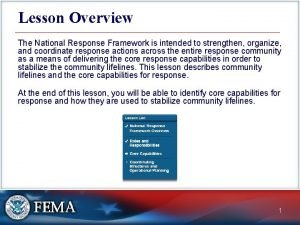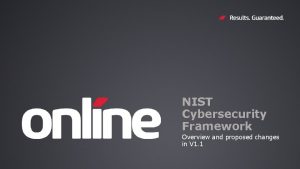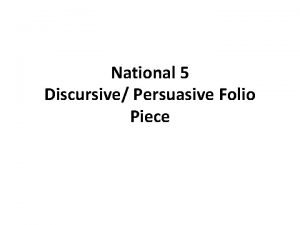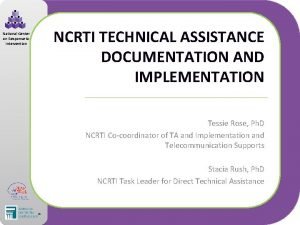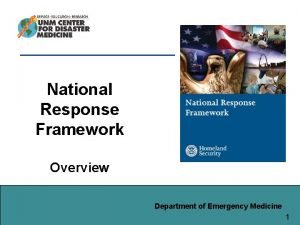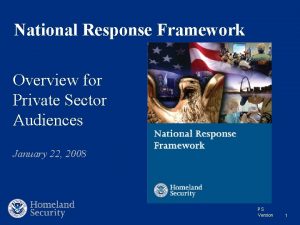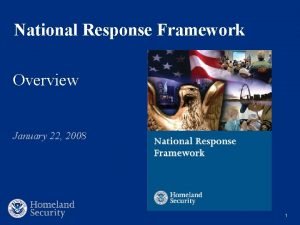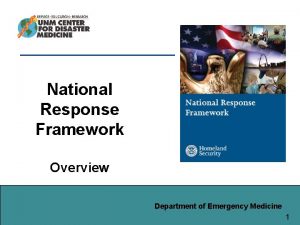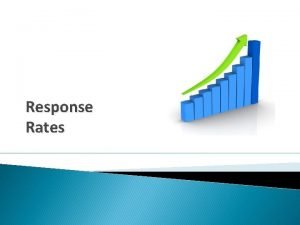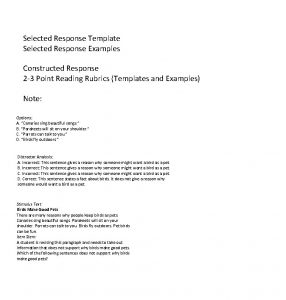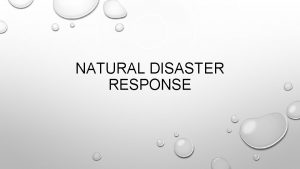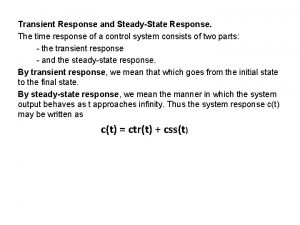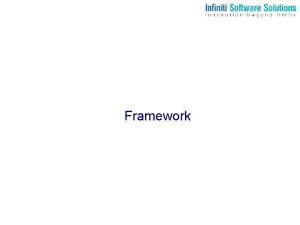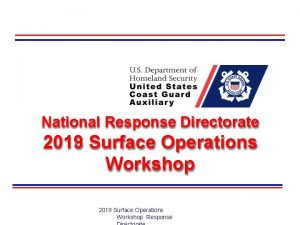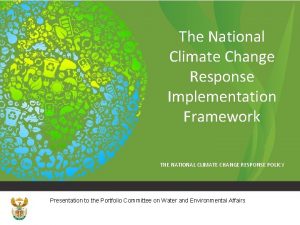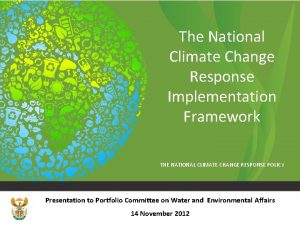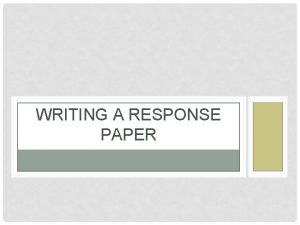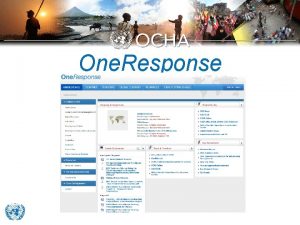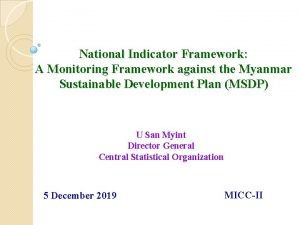The National Response Framework An Overview 1 Topics































- Slides: 31

The National Response Framework An Overview 1

Topics § NRF background, purpose, key concepts § How the Framework is organized § Applying the NRF § Leadership and the NRF (Federal, State, Local, Private Sector, Nongovernmental Organizations) § Building new capability 2

The National Planning Frameworks… describe how the whole community works together to achieve the National Preparedness Goal: A secure and resilient nation with the capabilities required across the whole community to prevent, protect against, mitigate, respond to, and recover from the threats and hazards that pose the greatest risk. (http: //www. fema. gov/national-planning-frameworks) 3

MRC GEM’s mission is: to augment existing community health operations during large-scale emergencies, aid in response to pressing health care needs, and improve community emergency preparedness. 4

The National Planning Frameworks There is one Framework for each of the five preparedness mission areas: § National Prevention Framework § National Protection Framework § National Mitigation Framework § National Response Framework § National Disaster Recovery Framework 5

National Response Framework § Purpose § Guides how the nation conducts all-hazards incident response § Key Concepts § Builds on the National Incident Management System (NIMS) with its flexible, scalable, and adaptable coordinating structures § Aligns key roles and responsibilities across jurisdictions § Links all levels of government, private sector, and nongovernmental organizations in a unified approach to emergency management § Always in effect: can be partially or fully implemented § Coordinates Federal assistance without need formal trigger 6

Focused on Response Achieving a Goal Within a Broader Strategy § Response § Immediate actions to save lives, protect property and the environment, and meet basic human needs § Execution of emergency plans and actions to support short-term recovery § National Strategy for Homeland Security – guides, organizes and unifies our National homeland security efforts § Prevent and disrupt terrorist attacks; § Protect the American people, our critical infrastructure, and key resources; § Respond to and recover from incidents that do occur; and § Continue to strengthen the foundation to ensure our long-term success. 7

National Preparedness Goal: The 14 Response Core Capabilities § Planning (all) § Public Information and Warning (all) § Operational Coordination (all) § Critical Transportation § Environmental Response/Health and Safety § Fatality Management Services § Infrastructure Systems (also Recovery) (http: //www. fema. gov/core-capabilities) 8

National Preparedness Goal: The 14 Response Core Capabilities § Mass Care Services § Mass Search and Rescue Operations § On-Scene Security and Protection § Operational Communications § Public and Private Services and Resources § Public Health and Medical Services § Situational Assessment (http: //www. fema. gov/core-capabilities) 9

National Preparedness Goal: The Other Mission Areas’ 17 Core Capabilities • • Forensics and Attribution (Prevention) Intelligence and Information Sharing (Prevention, Protection) Interdiction and Disruption (Prevention, Protection) Screening, Search, and Detection (Prevention, Protection) Access Control and Identity Verification (Protection) Cybersecurity (Protection) Physical Protective Measures (Protection) Risk Management for Protection Programs and Activities (Protection) • Supply Chain Integrity and Security (Protection) (http: //www. fema. gov/core-capabilities) 10

National Preparedness Goal: The Other Mission Areas’ 17 Core Capabilities • • Community Resilience (Mitigation) Long-term Vulnerability Reduction (Mitigation) Risk and Disaster Resilience Assessment (Mitigation) Threats and Hazard Identification (Mitigation) Economic Recovery (Recovery) Health and Social Services (Recovery) Housing (Recovery) Natural and Cultural Resources (Recovery) (http: //www. fema. gov/core-capabilities) 11

CDC’s 15 Public Health Preparedness Capabilities • • Community Preparedness Community Recovery Emergency Operations Coordination Emergency Public Information and Warning Fatality Management Information Sharing Mass Care Medical Countermeasure Dispensing (http: //www. cdc. gov/phpr/capabilities/index. htm) 12

CDC’s 15 Public Health Preparedness Capabilities • • • Medical Materiel Management and Distribution Medical Surge Non-Pharmaceutical Interventions Public Health Laboratory Testing Public Health Surveillance and Epidemiological Investigation • Responder Safety and Health • Volunteer Management (http: //www. cdc. gov/phpr/capabilities/index. htm) 13

How the Framework is Organized Core Document Doctrine, organization, roles and responsibilities, response actions and planning requirements that guide national response (updated 2013) Emergency Support Function Annexes Mechanisms to group and provide Federal resources and capabilities to support State and local responders Support Annexes Essential supporting aspects of the Federal response common to all incidents Incident Annexes Incident-specific applications of the Framework Partner Guides Next level of detail in response actions tailored to the actionable entity www. fema. gov/nrf 14

The NRF… § is a Framework … not a Plan § is written for two audiences § Senior elected and appointed officials § Emergency Management practitioners § emphasizes roles of the local governments, States, NGOs, individuals and the private sector § establishes Response Doctrine • • • Engaged partnership Tiered response Scalable, flexible, and adaptable operational capabilities Unity of effort through unified command Readiness to act § establishes planning as a critical element of effective response 15

Applying the Framework § Most incidents wholly managed locally § § Some require additional support Small number require Federal support Catastrophic requires significant Federal support State Governor must request Federal support § Minor event might be initial phase of larger, rapidly growing threat § Accelerate assessment and response § Federal Department/Agency acting on own authority may be initial Federal responder § Integrated, systematic Federal response intended to occur seamlessly 16

Federal Leadership and the Framework § Secretary of Homeland Security: Principal Federal official for domestic incident management § FEMA Administrator: Principal advisor to the President, Secretary of Homeland Security, and Homeland Security Council regarding emergency management. § Principal Federal Official (PFO): Secretary’s primary representative to ensure consistency of Federal support as well as the overall effectiveness of Federal incident management. § For catastrophic or unusually complex incidents requiring extraordinary coordination § Interfaces with Federal, State, tribal, and local officials regarding Federal incident management strategy; primary Federal spokesperson for coordinated public communications § Federal Coordinating Officer (FCO): For Stafford Act events, the primary Federal representative to interface with the SCO and other State, tribal, and local response officials to determine most urgent needs and set objectives. § Federal Departments and Agencies: play primary, coordinating, and support roles based on their authorities and resources and the nature of the threat or incident Note: Consistent with the Post-Katrina Emergency Management Reform Act 17

State & Local Leadership and the Framework Effective, unified national response requires layered, mutually supporting capabilities § States are sovereign entities, and the Governor has responsibility for public safety and welfare; States are the main players in coordinating resources and capabilities and obtaining support from other States and the Federal government § § Governor Homeland Security Advisor Director State Emergency Management Agency State Coordinating Officer State & Tribal Governments § Local officials have primary responsibility for community preparedness and response NRF § Elected/Appointed Officials (Mayor) § Emergency Manager § Public Safety Officials § Individuals and Households are key starting points for emergency preparedness and support community efforts Local Governments Federal Government Private Sector & NGO 18

Private Sector & NGOs and the Framework Effective, unified national response requires layered, mutually supporting capabilities § The Private Sector supports community response, organizes business to ensure resiliency, and protects and restores critical infrastructure and commercial activity § NGOs perform vital service missions § Assist individuals who have special needs § Coordinate volunteers § Interface with government response officials at all levels State & Tribal Governments Local Governments NRF Private Sector & NGO Federal Government 19

The Framework: Building New Capability § Preparedness Cycle–a system that builds the right capabilities § § Introduces National Planning System Defines response organization Requires training Advocates interoperability and typing of equipment § Emphasizes exercising with broadbased participation § Describes process for continuous evaluation and improvement § Aligning Risk-Based Planning Plan Evaluate & Improve Capability Building Organize, Train & Equip Exercise § National Planning Scenarios § Hazard Identification and Risk Analysis 20

NRF: Equipping Leaders, Practitioners, and Individuals Improve coordination among Federal, State, local, and tribal organizations to help save lives and protect America's communities by increasing the speed, effectiveness, and efficiency of response. 21

Emergency Support Functions / Annexes • • • • ESF #1 - Transportation ESF #2 - Communications ESF #3 - Public Works and Engineering ESF #4 - Firefighting ESF #5 - Emergency Management ESF #6 - Mass Care, Emergency Assistance, Housing and Human Services ESF #7 - Logistics Management and Resource Support ESF #8 - Public Health and Medical Services ESF #9 - Search and Rescue ESF #10 - Oil and Hazardous Materials Response ESF #11 - Agriculture and Natural Resources ESF #12 - Energy ESF #13 - Public Safety and Security ESF #14 - Long-Term Community Recovery ESF #15 - External Affairs 22

Support Annexes • Critical Infrastructure and Key Resources • Financial Management • International Coordination • Private Sector Coordination • Public Affairs • Tribal Relations • Volunteer and Donations Management • Worker Safety and Health Incident Annexes • • Biological Incident Catastrophic Incident Cyber Incident Food and Agriculture Incident Mass Evacuation Incident Nuclear/Radiological Incident Terrorism Incident Law Enforcement and Investigation 23

Stakeholder Responsibilities • Individuals and Households: Though not formally part of emergency operations, individuals and households play an important role in the overall emergency management strategy. They can contribute by reducing hazards in and around their homes, preparing emergency supply kits and household emergency plans, and monitoring emergency communications carefully. • Local Government: Responsibility for responding to incidents begins at the local level with individuals and public officials in the county, city, or town affected by the incident. Local officials are responsible for ensuring public safety and welfare of people of that jurisdiction. The local emergency manager has the day-to-day authority and responsibility for overseeing emergency management programs and activities. 24

Stakeholder Responsibilities • States and Tribal Governments: A primary role of State government is to supplement and facilitate local efforts before, during, and after incidents. Governors, State homeland security advisors, State emergency management directors, and tribal leaders have key roles and responsibilities for incident management. • Private Sector: In many facets of an incident, the government works with private sector groups as partners in emergency management. Many private sector organizations operate and maintain major portions of the critical infrastructure. • Nongovernmental Organizations: NGOs play an enormous role in emergency management before, during and after an incident. For example, NGOs provide sheltering, emergency food supplies, counseling, and other vital services to support response and promote the recovery of disaster victims. 25

Federal Department & Agency Responsibilities • Understand Key Framework Concepts • Structure, organization, roles and responsibilities • Attain High Level of Preparedness • Plan • Organize • Equip and Train • Exercise • Evaluate/Improve • Build Capabilities • Execute an Effective Response • Gain and maintain situational awareness • Activate and deploy resources and capabilities “The effectiveness of our efforts will be determined by the people who fulfill key roles and how they carry out their responsibilities, including their commitment to develop plans and partnerships, conduct joint training and exercises, and achieve shared goals. ” National Strategy for Homeland Security • Coordinate response actions • Demobilize 26

http: //www. phe. gov/preparedness/Pages/default. aspx 27

28

29

30

Questions? A copy of this presentation (and many others) is available on our web site, http: //mrcgem. com, at the “Reference” tab. 31
 Stabilizing community lifelines is primary effort during
Stabilizing community lifelines is primary effort during Spring framework overview
Spring framework overview Eylf meaning
Eylf meaning Nist cybersecurity framework overview
Nist cybersecurity framework overview Overview on the national tuberculosis elimination program
Overview on the national tuberculosis elimination program National 5 persuasive essay
National 5 persuasive essay Natural response and forced response
Natural response and forced response What is natural response
What is natural response A subsequent
A subsequent National center for response to intervention
National center for response to intervention National center on response to intervention
National center on response to intervention Dispositional framework vs regulatory framework
Dispositional framework vs regulatory framework How to explain conceptual framework
How to explain conceptual framework Franmework
Franmework Theoretical framework
Theoretical framework Dispositional framework vs regulatory framework
Dispositional framework vs regulatory framework Theoretical framework
Theoretical framework Hình ảnh bộ gõ cơ thể búng tay
Hình ảnh bộ gõ cơ thể búng tay Ng-html
Ng-html Bổ thể
Bổ thể Tỉ lệ cơ thể trẻ em
Tỉ lệ cơ thể trẻ em Chó sói
Chó sói Tư thế worm breton
Tư thế worm breton Hát lên người ơi alleluia
Hát lên người ơi alleluia Các môn thể thao bắt đầu bằng tiếng bóng
Các môn thể thao bắt đầu bằng tiếng bóng Thế nào là hệ số cao nhất
Thế nào là hệ số cao nhất Các châu lục và đại dương trên thế giới
Các châu lục và đại dương trên thế giới Công thức tiính động năng
Công thức tiính động năng Trời xanh đây là của chúng ta thể thơ
Trời xanh đây là của chúng ta thể thơ Cách giải mật thư tọa độ
Cách giải mật thư tọa độ 101012 bằng
101012 bằng Phản ứng thế ankan
Phản ứng thế ankan
